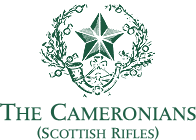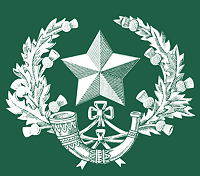 |
www.cameronians.org click here to print this page |
|
|
|
The Origins - Formation of The Cameronians (Scottish Rifles) - Between the Wars - The Cameronians Badge
The Cameronians were a unique part of Scottish history for over three hundred years. Their origins lie in the turbulent period of religious and political strife of the 1680's. Their end came with the defence cuts of the 1960's; their name finally erased from the Army List in 1995.
The original Cameronians were zealous Covenanters. Their devotion to the National Covenant (1638) and the Solemn League and Covenant (1643) meant that they would even do battle to defend their freedom to worship as they chose. Their heartland was in south west Scotland, in Galloway, Ayrshire, and in Clydesdale in particular.
When the crown ejected ministers from their parishes for refusing to submit to the rule of bishops, the Covenanters followed them to the hills and worshiped at open air services which came to be called conventicles. As the threat from government forces increased the Covenanters began to carry weapons to their conventicles and to post armed pickets to keep a lookout. This tradition was carried on through war and in peace until the day the Cameronians were eventually disbanded
The Regiment was formed in one day, 14 May 1689, 'without beat of drum'. They mustered on the holm, on the banks of the Douglas Water in South Lanarkshire. Their first Commanding Officer was William Cleland whilst their Colonel was the 19 year old Earl of Angus, son of the Marquis of Douglas. The Earl's magnificent statue overlooks the spot in Douglas to this day.
The Regiment took its name from Richard Cameron, 'The Lion of The Covenant'. Originally a field preacher he was killed, a bounty on his head, at the battle of Airds Moss in 1680. Cleland had led the Covenanters in battle at Drumclog and Bothwell Brig. His sword, one of the treasures of the Regiment, can still be seen today in the Regimental Museum in Hamilton. There too is the 'Bloody Banner' carried by the Covenanters at both battles.
Within weeks of their formation The Cameronians saw action as regular soldiers at the Battle of Dunkeld*. There they showed their mettle with a staunch defence against a hugely superior number of rebel Highland troops, though it cost the life of the 28 year old Cleland. This fighting spirit was carried on in campaigns all over the world for the next 300 years. From 1750 they, like all of the regiments of the line, were given a number and were thereafter known as the 26th Regiment of Foot, The Cameronians.
Formation of The Cameronians (Scottish Rifles)
As the 18th century drew to a close Britain faced the threat of war with the French. To counter this the government authorised the raising of a number of new regiments. Amongst them were the 90th (Perthshire Light Infantry) as well as the 91st (The Argyll & Sutherland Highlanders) and the 92nd (The Gordon Highlanders). Our story concerns the first of these, the 90th, and how, in 1881 they were brought together with the 26th of Foot to form what was to become The Cameronians (Scottish Rifles).
The man who raised the 90th was a Perthshire laird, Thomas Graham of Balgowan. He was born in 1746 and in 1774 he married the Hon. Mary Cathcart. So great was her beauty, and legendary charm, that the famous and fashionable artist Thomas Gainsborough painted her portrait no fewer than four times.
Sadly her health was delicate and a constant concern. They spent much of their time travelling, not least to try to find weather more congenial to her health. They were sailing in the Mediterranean in 1792 when she died.
While her coffin was being brought home by Graham through revolutionary France it was desecrated by an unruly mob of half-drunken men, who searched the corpse for gold in her teeth or rings on her hands. This incident profoundly shocked Graham and filled him with an unrelenting hatred of the French. Whilst he was in Britain burying his beloved wife, France declared war on Great Britain. He therefore set off to check first whether, in his mid-forties, he still had the mettle to be a soldier, and then to raise a regiment against them.The 90th Perthshire Volunteers were raised in 1794 and by the following year had seen action in France. They acquitted themselves so well throughout the Napoleonic Wars that, on their return from Canada in 1815, they were redesignated as Light Infantry. The 90th Perthshire Light Infantry (or the 'Perthshire Greybreeks', as they were known) served in the Crimean War 1854 - 1856 and Private Alexander became the first man in the regiment to win the recently instituted Victoria Cross.
In 1857 they were in India where at the relief of Lucknow, one of the most famous operations in the Indian Mutiny, the regiment won a further six Victoria Crosses. After service in 1879 in South Africa during the Zulu War they were sent again to India and it was whilst there, in 1881, that they received news that they were to become part of a new regiment.
The army had long been in need of radical reform. One of these, known as the Cardwell Reforms, was the formation of larger, two battalion regiments. At the same time it was decided that a new, elite, regiment of Rifles be established in Scotland. Being the senior Scottish regiment with only one battalion The 26th Cameronians were selected for this promotion. The fact that they also had an incomparable record as rifle shots may have made their case even stronger. The 90th, with their long Light Infantry tradition were to be joined with them. Together they became the 1st and 2nd Battalions, The Cameronians (Scottish Rifles).
Undoubtedly a part of the 90th’s high reputation came from the fact that it had produced some very distinguished senior officers. Thomas Graham rose to the rank of General. He was the Duke of Wellington’s ablest commander and later made Lord Lynedoch.
The creation of the new regiment, The Cameronians (Scottish Rifles), was as a result of reforms to the whole structure of the army. It was decided that all line regiments should consist of two regular battalions, one to serve at home whilst the other served abroad, usually in India. Both battalions gave up their standard red coats and adopted the rifle green with black buttons traditional for elite rifle regiments.
Both battalions then served in South Africa and in India as well as at home. In World War I there were 27 battalions. Over 7,000 Cameronians lost their lives and a magnificent memorial in Kelvingrove, Glasgow, commemorates this.
The history of the various militia, volunteer and territorial battalions is to be found elsewhere. Their contribution to their country as well as to their regiment was enormous, especially in the two World Wars.
Between the Wars
Between the wars the 1st Battalion spent much of its time in India where it enjoyed outstanding sporting successes, not least at rifle shooting for which it had long been famous. The 1st Battalion also served in Ireland and China, the 2nd in Iraq and Palestine, and both Battalions on the the North-West Frontier of India.
Of the ten battalions that served in World War II, the 1st spent the entire time in the Far East distinguishing itself in the defence of India and as part of the famous Chindits who outwitted and eventually out-fought the Japanese in Burma.
Meanwhile in 1939 the 2nd Battalion went to France with the BEF and after heavy fighting in Belgium was evacuated at Dunkirk. Later they went to the Middle East before joining Montgomery's Eighth Army for the invasion of Sicily and the battle for Italy.The first of an ongoing series of post-war defence cuts came in 1945. The regiments which had been expanded to two regular battalions in 1881 were all reduced to one. By 1945 the 1st Battalion had been reduced by death and disease to little more than a cadre and it is they who were disbanded, the 2nd Battalion being re-designated the 1st.
The new 1st Battalion then saw service in Malaysia (against the communist terrorists), in Germany (as part of BAOR), in the Middle East (Oman - see below - and Jordan), Kenya (in the wake of the Mau Mau Uprising), Germany again, and finally, again on active service, on counter-terrorist operations in Aden in 1966/67.
With the third major round of cuts in 1967 it was announced that the 1st Battalion The Cameronians (Scottish Rifles) was to disband, thus ending nearly three hundred years of service to the Crown. The disbandment parade, in the form of a Conventicle, took place on the holm at Douglas on 14 May 1968. Fittingly the salute was taken by the then Earl of Angus, the 14th Duke of Hamilton (1903-1973).
In his sermon The Reverend Donald MacDonald, a much loved former Chaplain to both regular battalions, said:
" … So put pride in your step Cameronians! As you march out of the Army List, you are marching into history, and from your proud place there, no man can remove your name, and no man can snatch a rose from the chaplet of your honour."
- Transcript of the sermon by The Reverend Donald MacDonald
- Transcript of the speech by Lieut General Sir George Collingwood
- Transcript of speech by Major Philip Grant on the 40th Anniversary of Disbandment
 The
distinctive badge of The Cameronians (Scottish Rifles) incorporates
one of the oldest insignia in Scottish heraldry - the Douglas star. Its
first use dates from circa 1350. More properly it is called a roundel,
the wheel of a spur. Below the roundel is a bugle and ribbon signifying
a Light Infantry - or Rifle - regiment. They are surrounded by a wreath
of Scottish thistles.
The
distinctive badge of The Cameronians (Scottish Rifles) incorporates
one of the oldest insignia in Scottish heraldry - the Douglas star. Its
first use dates from circa 1350. More properly it is called a roundel,
the wheel of a spur. Below the roundel is a bugle and ribbon signifying
a Light Infantry - or Rifle - regiment. They are surrounded by a wreath
of Scottish thistles.
The Douglas tartan adopted by The Cameronians (Scottish Rifles) in 1890 is still worn today by the Pipers of the Royal Gurkha Rifles with whom the Regiment long had close ties.
Balmoral bonnets are worn to this day by soldiers of the Sultan of Muscat's Armed Forces. Such was the gratitude of the then Sultan, after an operation in Oman in his support by the 1st Battalion in 1957, that he copied this headdress for his own army. The present Sultan, HM Sultan Qaboos bin Said, served as an officer with the 1st Battalion in Germany in the early 1960's.
Source: Published by the Regimental Trustees, The Cameronians (Scottish Rifles)..
www.cameronians.org